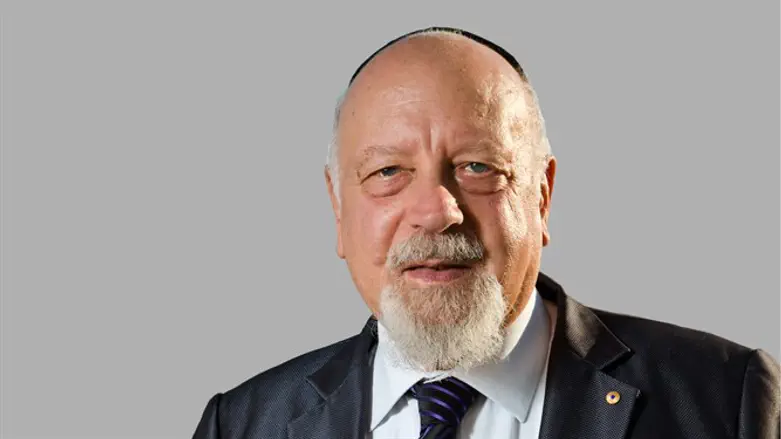
THE DIVINE IMAGE
Central to the Rosh Hashanah services are the twin concepts of God and Man.
Their partnership and dialogue is the theme of millennia of history.
Genesis begins with God making the world and crowning the Creation by making Man.
Where did God get the idea of Man? He looked at Himself and made Man in His image (Gen. 1:27).
The simplistic conclusion is that Man is a photograph of God. And that whatever man looks like, that suggests the Creator’s image.
It is an impossible interpretation since by definition God is totally non-physical and has no material shape or form. The word image cannot possibly be taken literally. Whatever it denotes, it has no connotation whatsoever of physical shape or bodily appearance.
The image that the Bible speaks of in relation to God has four aspects – intellectual, articulate, spiritual, and moral.
Man was made with these four characteristics – or rather, with the capacity to emulate them. God is the acme of perfection in each case.
Man cannot possibly be or become God but he is capable of gradually-growing godliness, making him (Psalm 8), "just beneath the angels".
ALPHABETS & ACROSTICS
The High Holyday services are full of alphabetical acrostics, poems and prayers where the initial letters of words, lines and stanzas follow the order of the Hebrew alphabet or the letters of the author’s name.
This device dates back to the time before printing, when it was hard to remember the sequence of the verses by heart. "Acrostic" entered English in the 16th century, deriving from a Greek word. In the Bible acrostics are common, e.g. in the long Psalm 119.
In "Ashrei", Psalm 145, the lines are in alphabetical order except that there is no verse beginning with "n". The Talmudic view is that the missing verse was dropped because it had unpleasant words beginning "naf’lah", "fallen".
Many of our Sabbath and festival songs have acrostics; alphabetically in "Addir Hu" and using the author’s name in "Ma’oz Tzur". The Book of Lamentations ("Echah") has four alphabetical chapters and one non-alphabetical.
But how can a poem flow naturally if it has to fit into a predetermined structure?
The Midrash explains the alphabetical structure of the list of sins ("Ashamnu, Bagadnu, Gazalnu") on the basis that we have committed every sin from "alef" to "tav".
Acrostics of the author’s name look like a wish for immortality but it saves the reader from having to remember the text unaided.
An acrostic adds to the impact of the poem in that it provides a visible shape and not simply an aural effect.
MENDING THE MEANING – HOW "TIKKUN OLAM" HAS CHANGED
On Rosh Hashanah morning, the introduction to the "Malchiyot" section of "Musaf" is the poem which we know as "Alenu".
"Alenu" tells us that Judaism has a double duty – to create a believing, committed community, and through "tikkun olam" to mend the world.
However, the term "tikkun olam" has a long lineage and its meaning has changed over the centuries.
Originally it indicated preparing the world for the coming of God’s kingdom ("l’takken olam b’malchut Sha-d-dai"). It is in this sense that the phrase is used in the second paragraph of "Alenu", which speaks of defeating and destroying all idols and making the world ready for God’s rule.
The mystics spoke of the completeness of the post-B’reshit world being shattered and humanity being engaged in seeking the broken shards. Until these shards are found and restored to their place, God does not rule and His word does not hold sway.
"Tikkun Olam" historically was preparation, not purpose – the means to an end – but now it seems to have become the purpose itself.
ONE IN A HUNDRED
Rabbi Levi Yitzchak of Berditchev said to God one Rosh Hashanah:
"Ribbono Shel Olam, Master of the World!
"You ordained 'a day of t’ru’ah' – blowing the shofar (Num. 29:1). See how much Your children love You! You commanded a 't’ru’ah' – and they blow a hundred notes.
"Thousands, tens of thousands, millions of Your people Israel have blown those hundred notes for millennia.
"How many shofar notes have been sounded over the ages? No-one can count them. But at the same time they have called upon You with the words, 'T’ka b’shofar gadol l’cherutenu' – 'God, blow just one note on Your great shofar to herald the beginning of our freedom and redemption.
"God, You asked us for one 't’ki’ah', and we give You a hundred multiplied over and over again. All we ask from You is one 't’ki’ah'. Why can’t You give us just that one note?"
A modern Levi Yitzchak would not leave it at that. This might be what he says:
"Ribbono Shel Olam, Your people suffer so much. Please hasten the day of their redemption. They really try to be good human beings but they have to fight an environment of immorality.
"They try to be good Jews but they have to struggle against temptations that are hard to resist. They enrich the world but they receive insults in return.
"They have a tiny Holy Land where they work miracles but even some of their own people want to dismember it. They know You are on their side but they yearn for a sign of Your love.
"I implore You, Ribbono Shel Olam, come to their rescue with Your one shofar note!"
Rabbi Dr.Raymond Apple was for many years Australia’s highest profile rabbi and the leading spokesman on Jewish religious issues. After serving congregations in London, Rabbi Apple was chief minister of the Great Synagogue, Sydney, for 32 years. He also held many public roles, particularly in the fields of chaplaincy, interfaith dialogue and Freemasonry, and is the recipient of several national and civic honours. Now retired, he lives in Jerusalem and blogs at http://www.oztorah.com